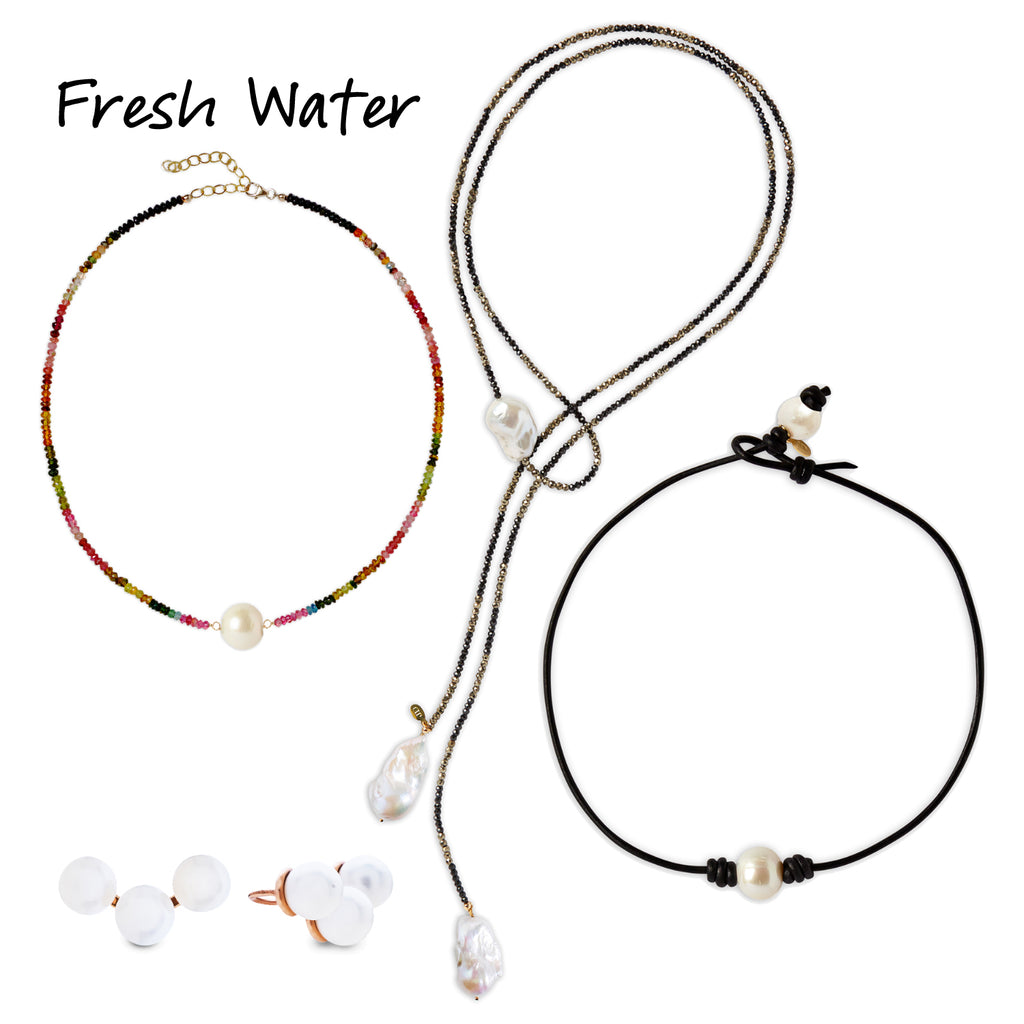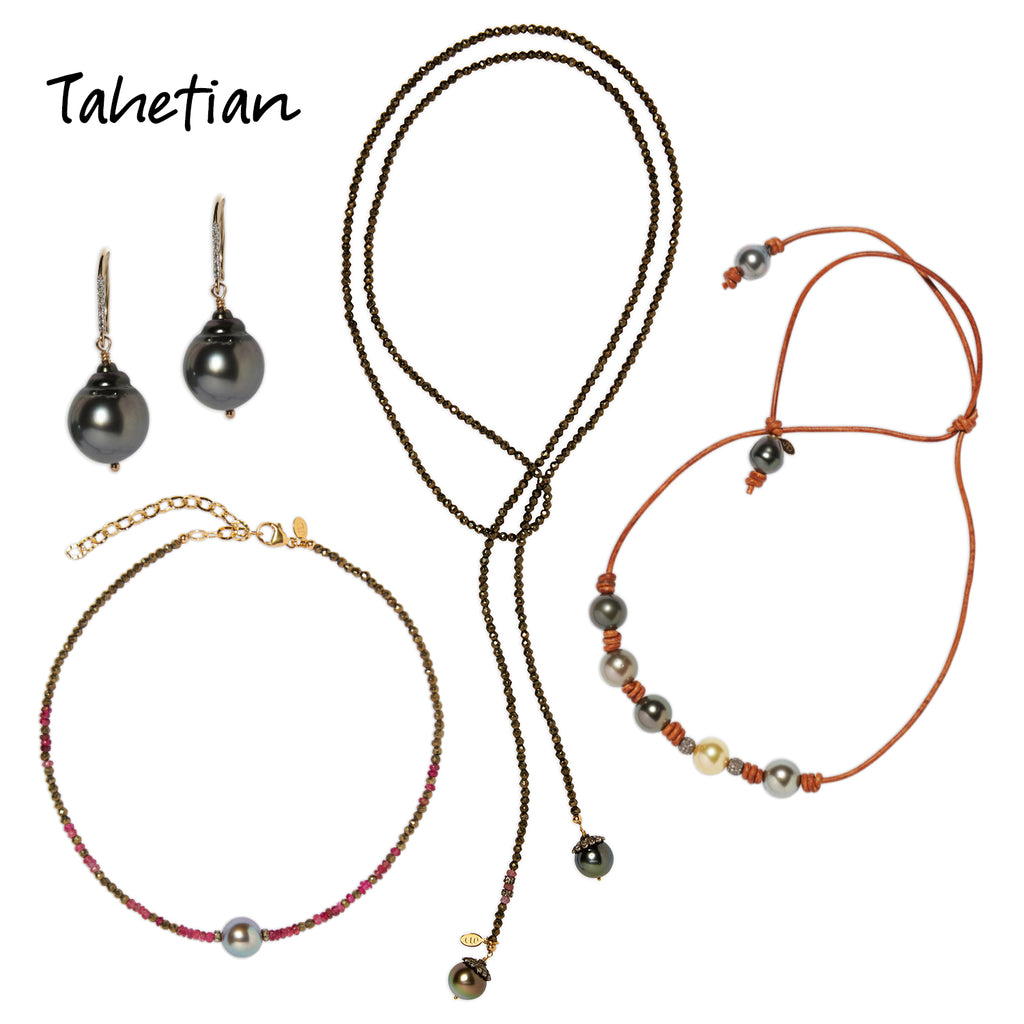Pearls are classic – one of the oldest, spectacular, and most desired gemstones. Whether one is looking for unique pearl lariats to lift their casual outfits or stunning bridal pearl jewelry, pearls are adored universally – and have been for decades and centuries.
One of our most frequently asked questions at Joie DiGiovanni Jewelry when it comes to pearls is, “What’s the difference between a freshwater pearl and a Tahitian pearl?” And rightly so! With all the different types of pearls available out there, it’s natural to wonder what are the unique characteristics of each and how this can help you make a better-informed decision regarding your pearl jewelry purchases.
So, in this blog post, we have put together a detailed guide for you to highlight the major differences between freshwater and Tahitian pearls. Let’s get started.
What are freshwater pearls?
As the name suggests, freshwater pearls are grown and found in freshwater bodies like lakes, rivers, and ponds. Here’s an interesting fact: the mollusks living in freshwater bodies can produce up to 50 freshwater pearls at a time!
They are generally the most commonly produced pearls. And their wide range of colors and unique sizes and shapes combined with their charming character and prices have given them a place at the top of the list of many shoppers, pearl connoisseurs, and designers.
Freshwater pearls are adored for their soft luster, elegant shapes, and white and pastel colors. Whether you want a free-form baroque or a perfectly round gemstone, these pearls have a variety of sizes to choose from.
However, it can be difficult to find the ones that are lustrous and round and can only be found at high-end jewelry stores. At Joie DiGiovanni Jewelry, we provide the highest-quality freshwater round AA and AAA pearls, as well as AA and AAA baroque pearls.
From our Freshwater Pearl Leather Choker and Multi Tourmaline Gemstone Necklace to our Pearl Crawler Earrings and Pyrite Baroque Pearl Lariat, our freshwater pearl pieces offer unique style and charm.

What are freshwater pearls made of?
Most freshwater pearls are commercially produced by Hyriopsis Schlegeli (Biwa shell) and Hyriopsis Cumingi (Triangle shell) in China – known for manufacturing most of the freshwater pearls in the market. Besides these two shells, freshwater pearls also come from other bivalve mollusks found in riverbeds, creek bottoms, and lakes of the United States and Japan.
Freshwater pearls are one of the unique types as they are the only cultured pearls that are tissue nucleated – they are entirely composed of nacre. As the mollusk coats the mantle tissue completely, the tissue fragment disintegrates, and as a result, a pearl made of solid nacre is produced.
Do freshwater pearls peel?
Real pearls can peel under certain circumstances – and they often do. This is because pearls are made of several layers of nacre – a composite material known as the “mother of pearl”. If these layers are not thick or any damage occurs to them, they can start peeling off from the pearl’s surface.
However, if we talk about freshwater pearls particularly, they come in natural shades of lavender, peach, and white and are not chemically treated or dyed. Hence, if they are kept with care and properly they will never fade, discolor, or peel.
Do freshwater pearls turn yellow?
Yes, all varieties of real pearls change their color over time which is a completely normal and natural process. The scientific reason behind this is that the pearls are made of organic compounds which change their composition as time passes.
However, the way pearls are taken care of and stored can affect the process and turn your pearls yellow faster. Avoid direct contact with perfume, makeup, tanning, and lotions to prevent tarnishing, marking, or discoloring the pearls
What are Tahitian pearls?
Tahitian pearls – also called exotic black pearls – come from the Black-lip pearl oyster or Pinctada margaritifera. They come in a wide range of overtones and body colors and are a lot more diverse in colors than black freshwater pearl or black Akoya.
Tahitian pearls offer an astounding range of colors that covers the spectrum - from pale dove grays and creamy whites to iridescent peacocks, majestic greens, and intense black. Classified as unique gems, these pearls come from different varieties of bivalve mollusks, and it takes them around two years to mature completely and be ready to harvest.
Traditionally, Tahitian pearls feature a satiny luster. They are the only dark naturally occurring pearls, grown and harvested in French Polynesia. Moreover, their shape depends on the amount of time they spend underwater.
If you are a fan of round pearls, then these pearls may not be your best bet. This is because a round shape in these pearls is extremely rare. But if baroque, drops and oval pearls make your heart beat faster, then Tahitian pearls are perfect for you. They typically range between 8mm to 15mm in size, from AA to AAA.
Our Tahitian (or South Sea) pearl jewelry offers the perfect combination of luxury and playfulness for the modern woman. Adorn yourself with our Pink Tourmaline Ombre Single Tahitian Pearl Gemstone Necklace or our South Sea Tahitian Pearl Ombre Leather And Diamond Necklace. Make a statement with our Labradorite And Peacock Tahitian Pearl Classic Gemstone Lariat or our Diamond Baroque Tahitian Pearl Drop Earrings All magnificent pieces that you will cherish forever.

Are Tahitian pearls freshwater or saltwater pearls?
Tahitian pearls are one of the three most common types of saltwater pearls including Cultured Saltwater Akoya and South Sea Pearls. Compared to freshwater pearls, saltwater pearls are quicker to grow organically. They are mainly found in atolls, bays, and inlets across China, Japan, Thailand, Indonesia, Australia, and Tahiti.
What Tahitian pearl colors are the best?
While buying your pearls it is important to look for colors that compliment your personality and skin tone. Pearls that are well-matched with your personality, as well as your outfit, can elegantly complete your look. See our blog post on how to style your pearl jewelry for inspiration.
Tahitian pearls offer a wide variety of colors, some of which are highly expensive such as cobalt blue and iridescent peacock. At Joie DiGiovanni Jewelry, we offer beautiful Tahitian pearls in a variety of shades and colors including the most popular golden, grays, and rainbow colors. Each color of these pearls can help you achieve different looks ranging from classy and sexy to fierce and successful.
How can you tell a real Tahitian pearl?
One doesn’t need to be a pearl connoisseur to know the difference between real and fake pearls. With basic knowledge, you can easily tell the difference between a real and fake Tahitian pearl. The major difference between the two is that the real Tahitian pearl will never be perfectly smooth, spherical, and matt under light.
Moreover, you can also check the authenticity of a real Tahitian pearl by its brightness. Depending on the exposure, the pearl must reflect light in specific ways. Lastly, while examining a Tahitian pearl, it is important to check if the surface is reflecting your own image or not. If it is, then you have a real pearl!
Freshwater vs. Tahitian pearls: which type of pearl is the best?
Both freshwater pearls and Tahitian pearls have their own unique qualities. But if you are a fan of shiny gems, it is important to know that freshwater pearls are generally less shiny as compared to saltwater or Tahitian pearls. This is because they contain thick nacre.
Tahitian pearls come with a higher price tag and are considered to be the second most valuable commercially farmed pearls in the world, due to their size. The larger the pearl, the more valuable it becomes. For example, Akoya pearls can only grow to about 9 or 10 millimeters in diameter, but Tahitian pearls can reach a diameter of around 15 or 16 millimeters. The larger size makes South Sea pearls and black pearls the most valuable type of pearl.
Whether you decide to buy freshwater pearls or Tahitian pearls is always a matter of function, cost and preference. Looking for perfectly round pearls that are affordable, versatile, and stylish? Choose freshwater pearls. Want something lustrous, unique and truly luxurious? Go for Tahitian pearls. Either way, pearls never disappoint!

